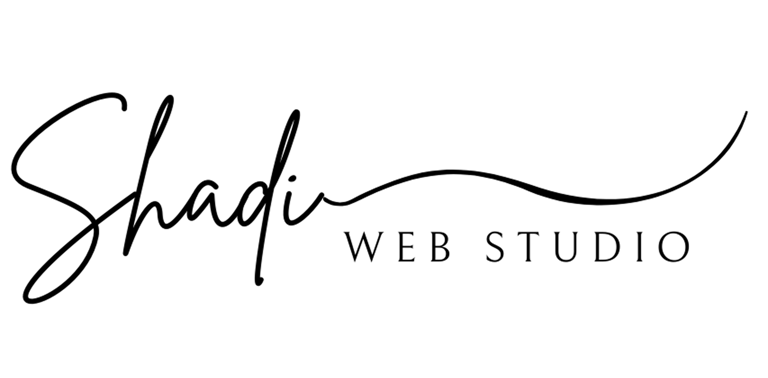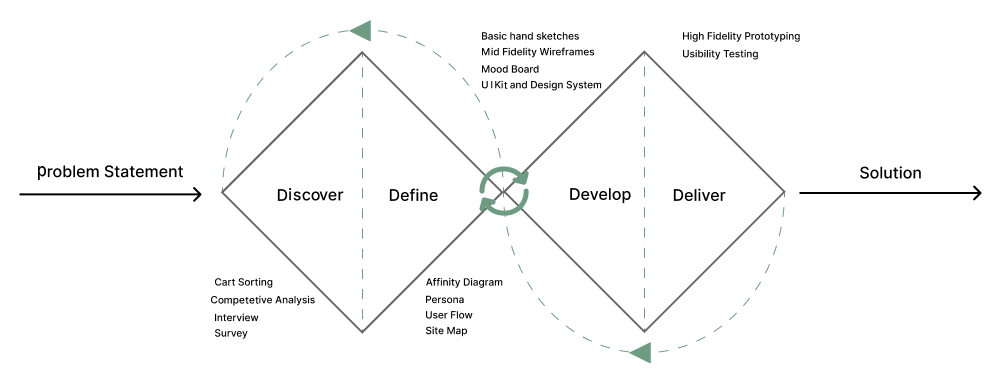RouteWise
A road trip planner from A to Z
Responsive web app / mobile application
RouteWise is an all-in-one road trip planning platform that simplifies every step of your journey in North America with key features, including:
Key Features:
Pre-Trip Planning: Choose your route, decide on your vehicle (own car or RV/ car rental), book places to stay, and plan activities, based on your destination, time, and budget. The app gives real-time cost estimates based on your choices
Real-Time Road Assistance: Get live updates during the trip, including weather and traffic alerts, so you can adjust plans easily.
Post-Trip Features: Share your travel diary, photos, and highlights with friends and the RouteWise community.
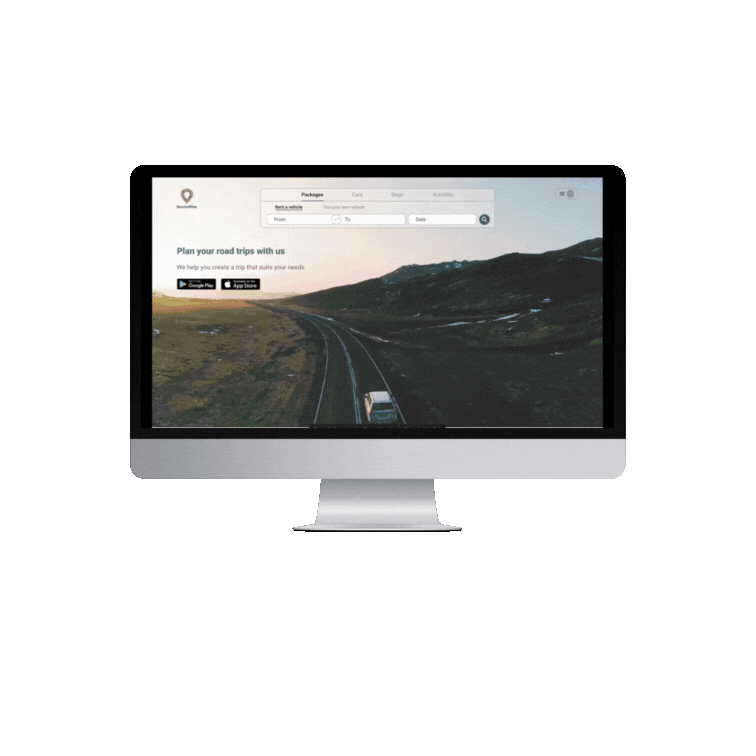



Note: In this step, the stakeholder asked us to focus on pre-trip planning as a package.
Project Overview


Target Users
1-All-Inclusive Trip Planners:
Users seeking a complete travel package with vehicle rental, route planning, accommodations, and activities.
2-Vehicle Renters:
People specifically interested in reserving a vehicle for their trip, who may want to customize their travel plans around their choice of transportation.
3-Accommodation Seekers:
Users looking to book accommodations for their trip, whether for one night or the entire journey, and plan around these bookings.
4-Activity Seekers:
Travelers looking to discover and book activities along their route for a more engaging journey.
This is a project I worked on during a bootcamp at UX-Land School, where I collaborated with my colleagues as both a UX researcher and UI designer.
I conducted interviews to understand user needs and contributed to designing a simple platform for customizing and booking road trips. The goal was to make travel planning easy and efficient for users by following the business value propositions.
Note: In this case study, we focused on desktop/app design for the first target groups
Stakeholder Needs
Challenges
Project Goals
Simple Booking Flow: Keeping multiple bookings (car, stays, activities) easy and fast in a single process..
Clear Cost Display: Showing costs without overwhelming users with numbers.
Personalized Choices: Offering relevant options based on users' preferences, needs, or past behavior, without adding unnecessary complexity, using filtering tools.
Easy Navigation: Ensuring smooth transitions between steps (e.g., car rental to booking stays).
Customizable Itinerary: Let users easily add, remove, or change bookings at the end, without cluttering the interface.
All-in-One Booking: Let users plan route, vehicle, stays, and activities, in one place.
Simple and Flexible Pathways: Build user loyalty and enthusiasm by offering a comfortable and adaptable experience, encouraging them to keep using our platform for booking hotels, cars, and more.
Accurate Cost Estimates: Show real-time clear costs to support budget-friendly planning.
Personalized Suggestions: Recommend routes, vehicles, and activities based on user preferences.
Flexible Customization: Allow route, vehicle, and stop adjustments as users plan.
Displaying Time and Budget for Each Route: How to present time and budget estimates for each route by considering various choices from start to finish.
Updating All Trip Details with Changes: Ensuring that any updates to a traveler’s route automatically adjust all related bookings and plans.
Separate Research for Booking Sections: In this project, each section—car/RV rental, accommodation, and activities—needed separate research. Due to time constraints, aside from considering users' needs for each section through interviews, I focused on competitive analysis for RV rental, hotel booking, and RV site reservations. I will continue with the remaining sections soon.






Designe Thinking
Discover
To understand the users' pain points and develop effective solutions, we employed a comprehensive research approach that consisted of the following methods:
Competitive Analysis
Survey
Interview & Affinity Diagram
Cart Sorting
Interview
For trip planning, we selected a package in this task that includes Road, Vehicle, Activities, and Accommodation. These areas required separate consideration, which we addressed individually during the interview process.
Competitive Analysis
We evaluated 12 online platforms related to road trips planning, RV/car rentals, and hotel/accommodation reservations, by examining important features based on stockholder needs. Using these features, we designed an all-in-one road trip planning that provides essential, easy-to-use tools.
Our analysis shows that Roadtrippers was the most competitive platform. However, it does not offer direct reservations for RVs, cars, or activities. Roadtrippers focuses on trip planning and provides information on routes, attractions, and accommodations, but users need separate services to make bookings. So, for accommodations, we conducted a competitive analysis on Expedia, Booking.com, Airbnb, and TripAdvisor. For car and RV rentals, Outdoorsy and similar platforms were analyzed.
Survey
We conducted an online survey and received 46 responses from relevant communities. Based on the feedback, we identified four key points to guide our design according to business needs.
Preference for Car and RV Travel: Many users like road trips, so the platform should offer features like car/RV-friendly routes, stops, and cost estimations for fuel and parking.
Comprehensive Planning Tools are Key: Users want cost estimates, interactive maps visualizations, route suggestions, and easy accommodation booking—all essential features.
Interest in Outdoor and Adventure Activities: Users value exploring new places, relaxation, adventure, and outdoor activities. This highlights the need to provide comprehensive information to ensure a comfortable and enjoyable trip while improving user satisfaction.
Gap for a comprehensive platform: Many still rely on Google Maps for trip planning, which lacks essential features. This platform should offer similar navigation and real-time updates, so users can rely on it for both planning and during their journey.
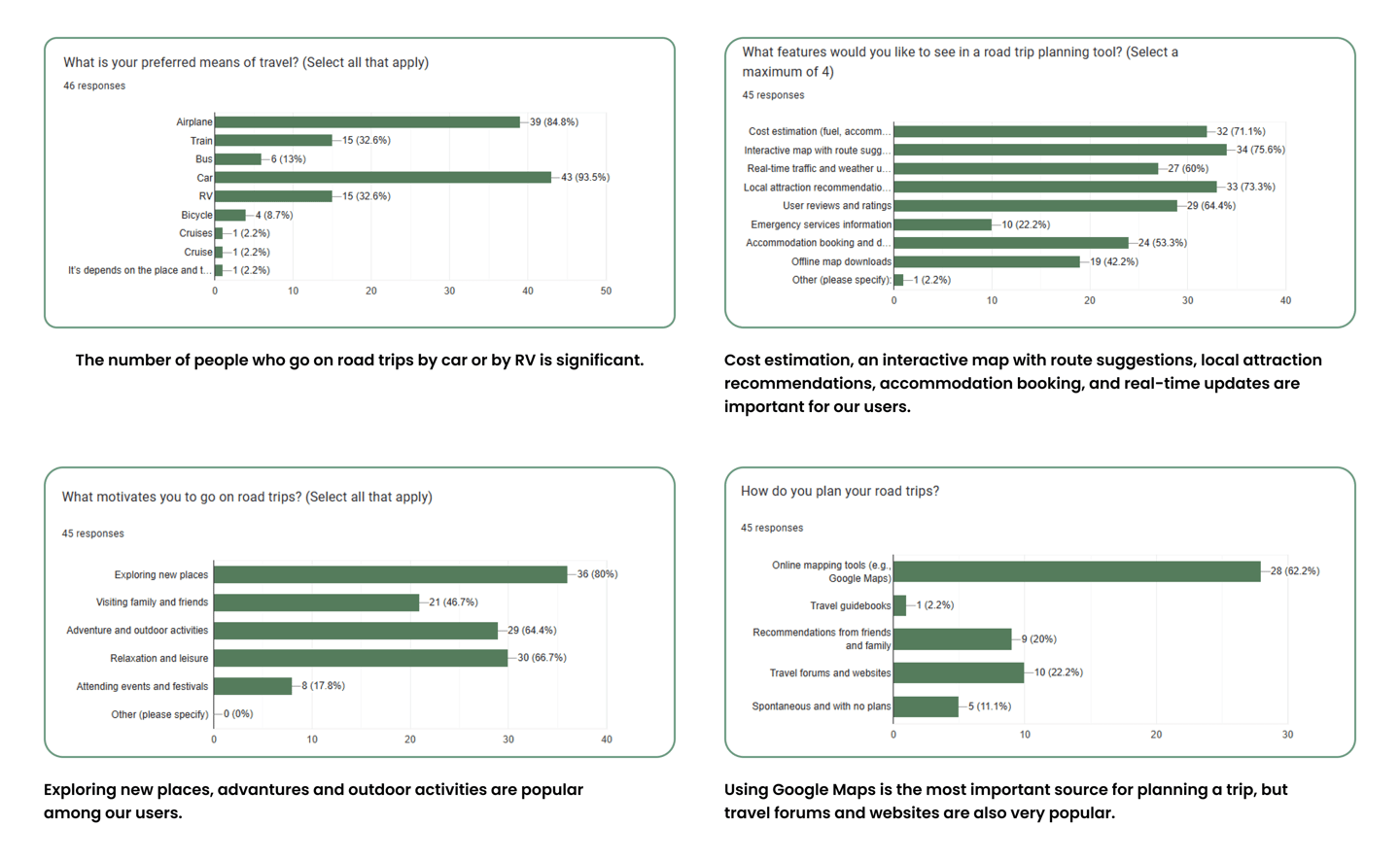

Vehicle Suitability: It’s important to have a vehicle that meets my needs and can handle different terrains.
Vehicle Amenities: It’s important to view the vehicle's amenities in detail.
RV Travel Experience: Traveling in an RV is different due to speed, city entry restrictions, parking spaces, and more. However, it’s great for resting with basic facilities wherever I stop.
Campsite Facilities: The quality of campsite facilities is important.
User Reviews: User opinions are crucial for choosing an accommodation.
Facility Checks: I need to check the type of facilities available for stops.
Updates on Sites: Keeping RV site information up-to-date is crucial to avoid surprises, like finding no water upon arrival.
Dining Search Issues: Finding dining or shopping options that match preferences is time-consuming.
Platform Expectations: I want a platform that shows the best places based on my current location or my interests to save time.
Reservation Needs: I need the ability to reserve popular places in advance, especially during peak times.
Essential Information: Details like emergency contacts, medical info, and car repair shops are necessary.
Accomadation
Road
Vehicle
Stops: Attractions & Activities
Audience top insight
Importance of Road Safety & Facilities: Road safety and available facilities are crucial.
Different Routes for Departure & Return: We like to take different routes for the departure and return to explore more attractions.
Challenges with Google Maps: Google Maps helps find places, but sometimes it leads to long detours with no good stops. Planning apps are useful, but many have high subscription costs.
Note: We identified user pain points and expectations and discussed them with our stakeholder. Based on their value proposition and limitations (time and budget), we began defining the design for the first phase.


Define
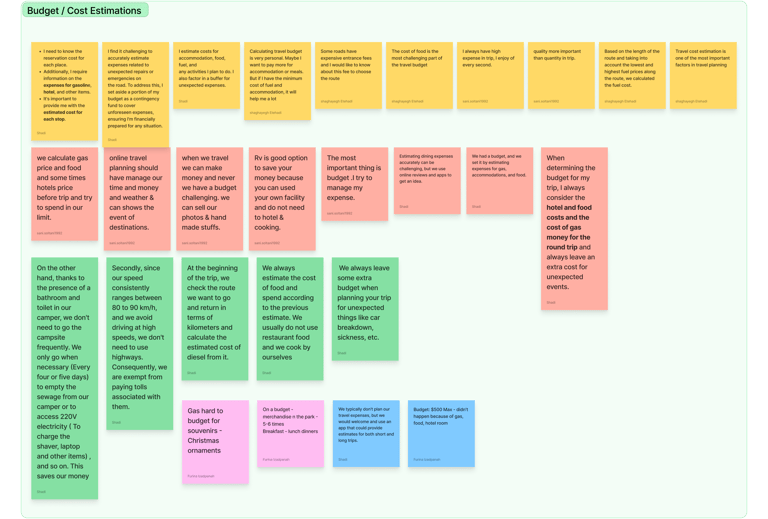

Affinity Diagram
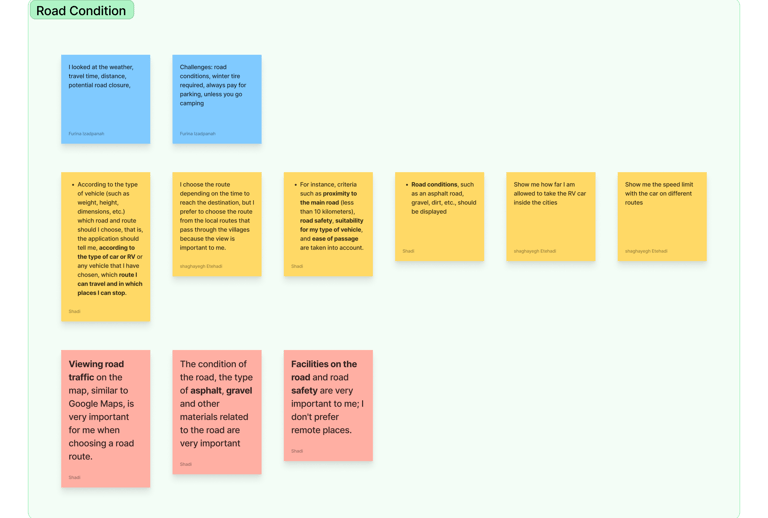

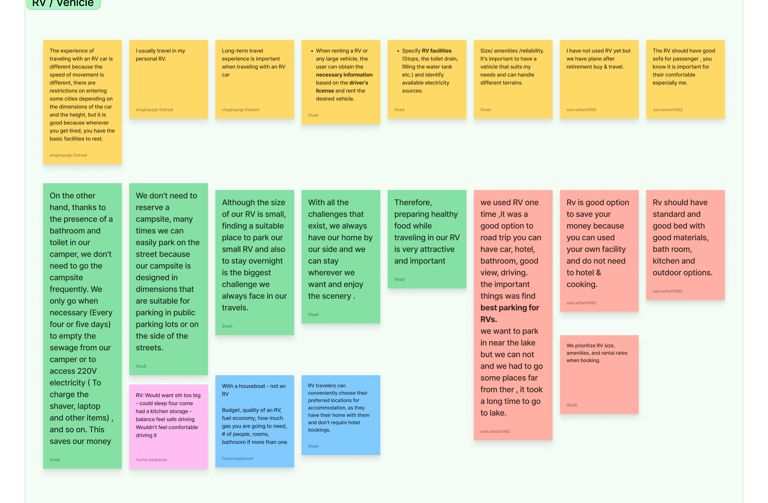

Road Condition
Budgeting
Vehicle/ RV Reservation
pain points
Estimating Travel Costs: Difficulty in predicting travel expenses.
Managing Unexpected Expenses: Challenges in handling unplanned costs.
High Fuel and Accommodation Costs: Struggles with high fuel and accommodation costs.
pain points
pain points
Expectations
Budget-Friendly Planning: A feature to help users manage major travel costs within their budget
Clear Pricing: Users expect transparent pricing.
Cost Breakdown: Users want a clear breakdown of trip costs for each participant that can be easily shared.
Budget Flexibility: Users want the ability to adjust plans easily to fit their budgets without confusion.
Lack of information on road conditions, safety, and vehicle-specific routes.
Real-time updates on traffic and detours would improve the journey.
Expectations
Personalized Route Suggestions: Users want routes based on options like fastest, optimal, or scenic, with filters for toll-free or paved roads.
Regular Updates: Users need clear and accurate updates during the trip about road changes or traffic issues without confusion or missing information.
Size and Comfort: Users may struggle to choose the right vehicle size for comfort and amenities.
Access Restrictions: Some locations have vehicle size restrictions or limited parking, reducing options.
Expectations
Clear Vehicle Information: Users expect detailed info about vehicle features, size, and suitability for their needs.
Filter Options: Users want to filter vehicles by amenities (e.g., beds, bathrooms, kitchen) and size to match their needs and budget.
Stops /Stays
Used Popular Applications



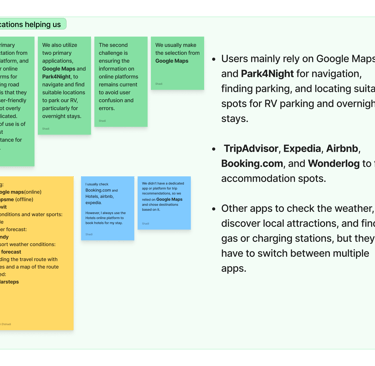
pain points
Expectations
Comprehensive Platform for Rest Stops and Attractions: Users expect detailed information about rest stops, tourist attractions, and accommodations to be centralized, clear, and easy to access in one platform.
Detailed Facility Insights: Users expect information on amenities—like parking, restrooms, safety, and nearby services at each stop—to be accessible, clear, and well-defined.
pain points
Lack of a Dedicated All-in-One Platform: Users mention there is no platform that consolidates everything they need (like stops, attractions, and parking) based on personalized preferences.
Switching Between Apps: Users find it inconvenient to use multiple platforms to get all the necessary information.
Simplicity and User-Friendliness: Users expect the platform to be easy to use and not overly complex.
Up-to-Date Information: It's essential for the platform to keep information current to prevent confusion and errors during trips.
Expectations
Lack of Attraction and Accommodation Info: Users have no dedicated comprehensive platform for finding information on scenic spots, tourist attractions, and accommodations—often relying on Google Maps but switching between platforms breaks the flow.
Our chosen persona represents users who value time management, budgeting, and organized planning. The users we interviewed are eager for road trips but avoid them due to limited time. They need a comprehensive platform to meet all their travel needs in one place, helping them manage both time and money while planning a memorable road trip.
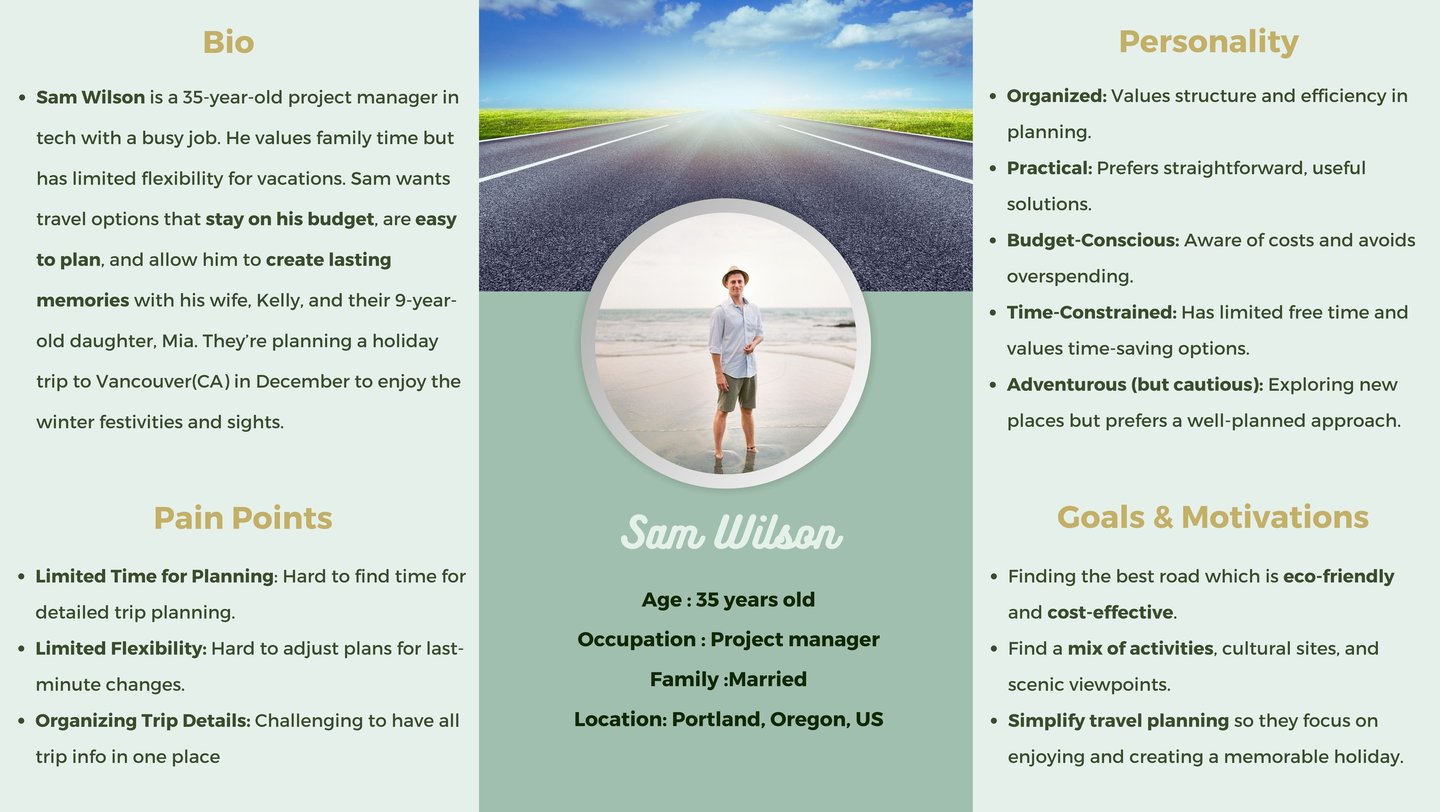

Persona
Site Map
To ensure our information architecture meets user expectations, we conducted 16 open card sorting using the Optimal Workshop platform. After the initial exercise, we developed our first version and iteratively refined it based on user testing and competitive analysis.
Here is our final site map:
We added a customization task to the user flow for personalized packages, providing a seamless experience for busy professionals like Sam.
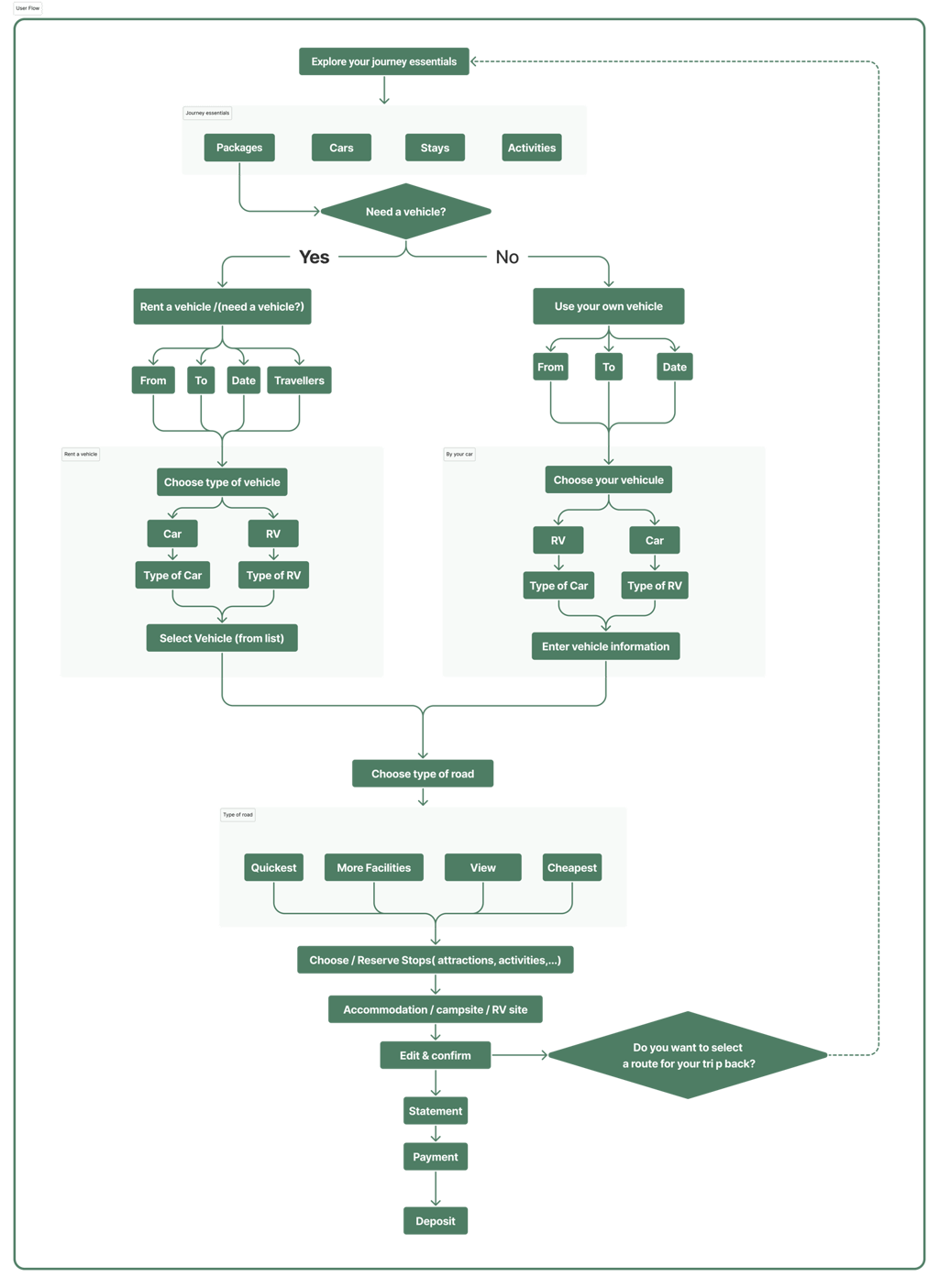

Final User Flow

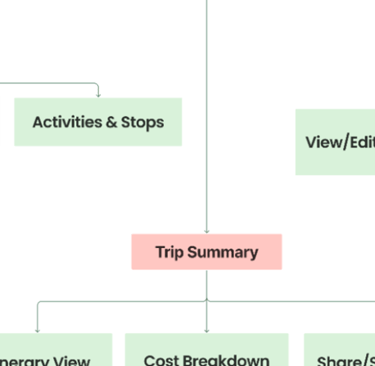
Develop
Challenges
----------------------------------------------------------------------------------------------------

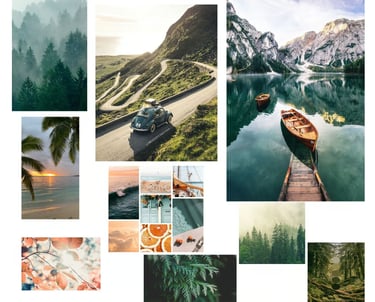
Solutions
----------------------------------------------------------------------------------------------------
----------------------------------------------------------------------------------------------------
----------------------------------------------------------------------------------------------------
xxxxxxxxxxxxxxxxxxxxxxxxxx : ------------------------------------------------------------------------------------------------------------------------------------------------------------------------------------------------------------------------------------------------------------------------------------------------------------
XXXXXXXXX: ----------------------------------------------------------------------------------------------------
XXXXXXXXXX: ----------------------------------------------------------------------------------------------------
XXXXXXX: ----------------------------------------------------------------------------------------------------
Sketches and Wireframes
We initially mapped out our ideation using hand-sketched low-fidelity wireframes, aiding communication within the team during the early design stages. Later, we transitioned to creating low-fidelity wireframes on Figma to visualize page layouts and design direction. These wireframes underwent several iterations before final content development.
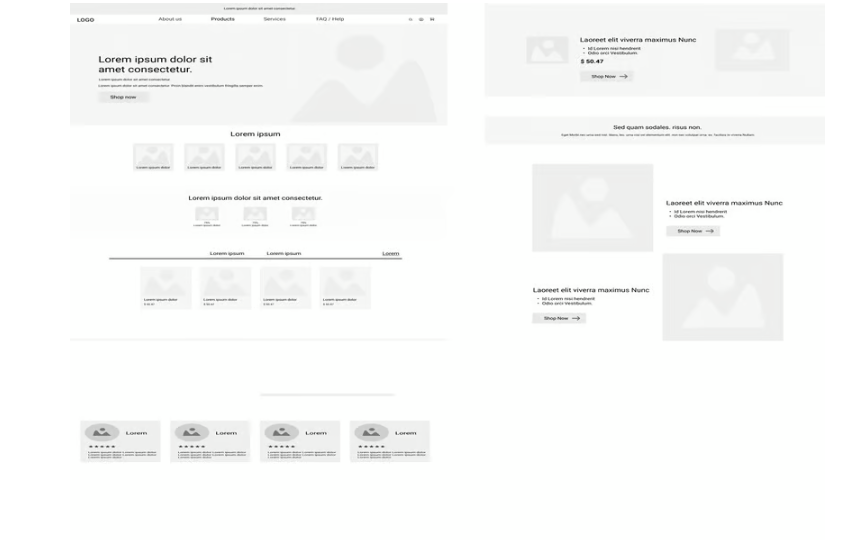



Moodboard
we shaped our mood board inspired by nature, ultimately arriving at a color palette that includes a variety of green shades symbolizing nature and vitality, along with cream tones inspired by the sunrise.
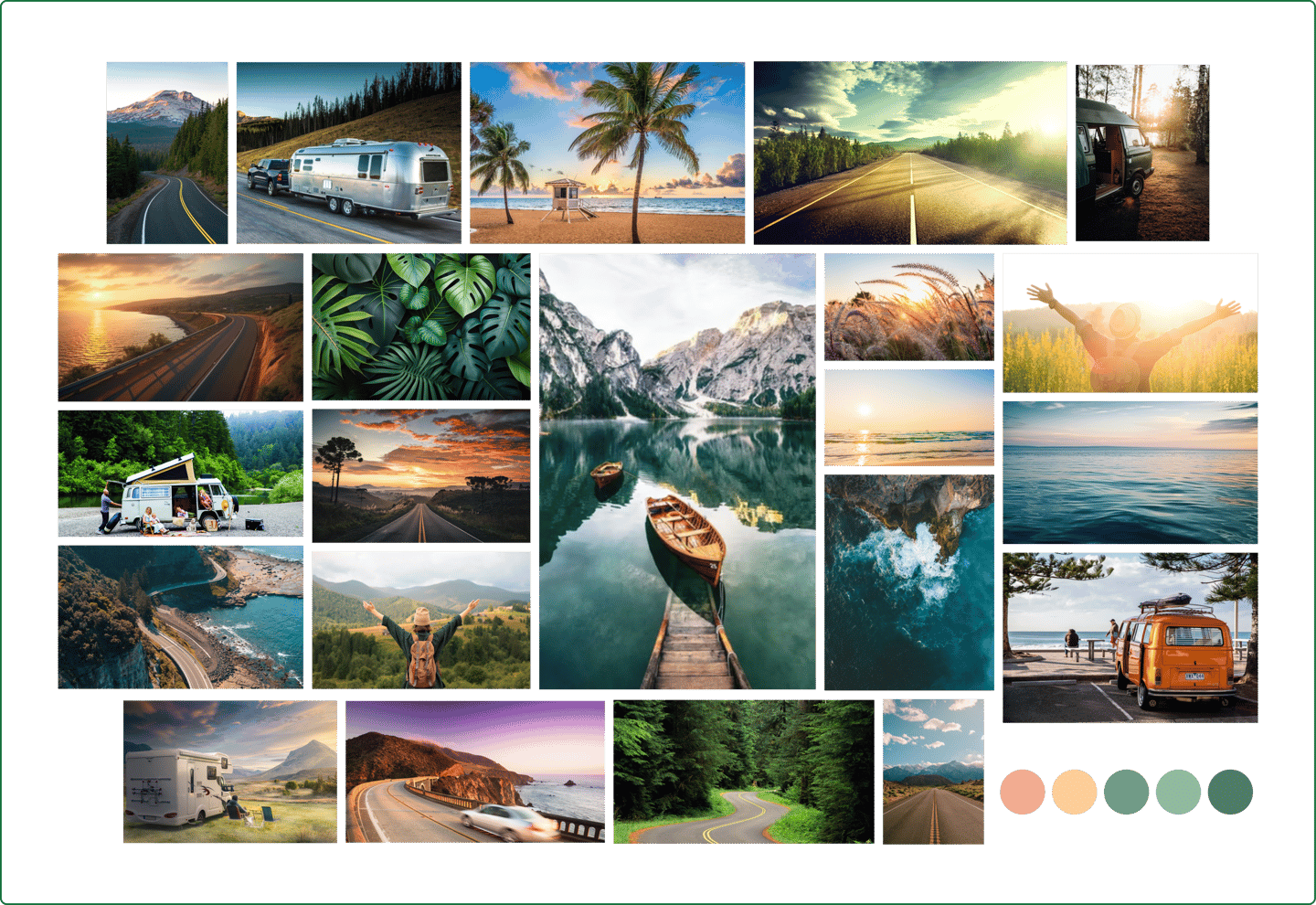

UI Kit
Our UI kit balances casualness with a color palette of dark & light green, light orange & brown tones, modern and easy-to-read fonts.
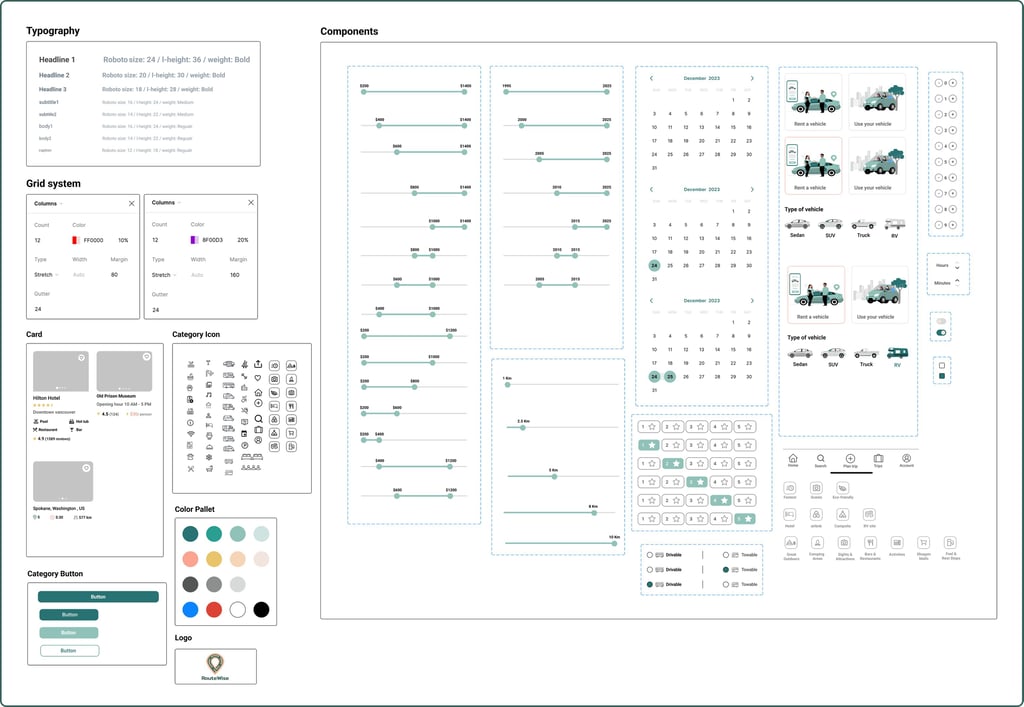

Deliver
High Fidelity Wireframe
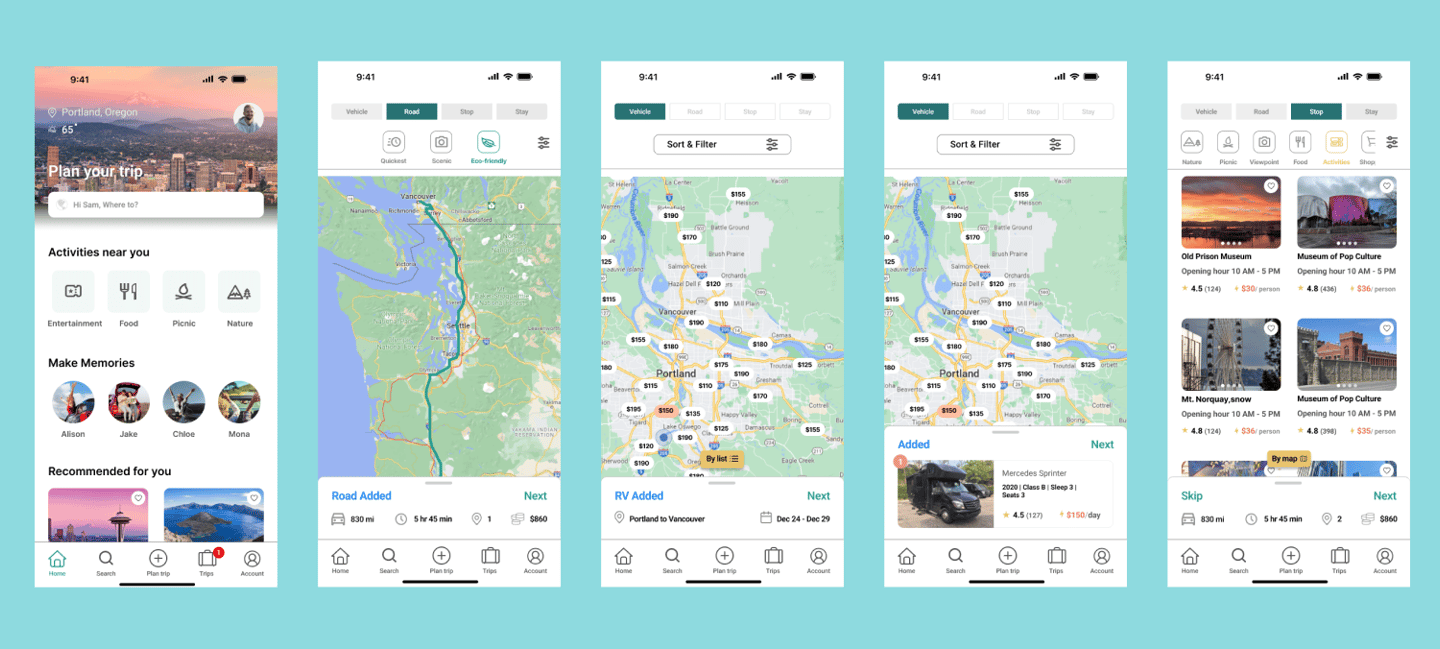

Protoype
Here is the last prototype, displaying what we've achieved through our design process.
Iteration and Usability Test
Throughout the project, we went through multiple iterations, driven by the insights we gained from usability tests. These tests were instrumental in shaping our decisions and constantly enhancing our project.


